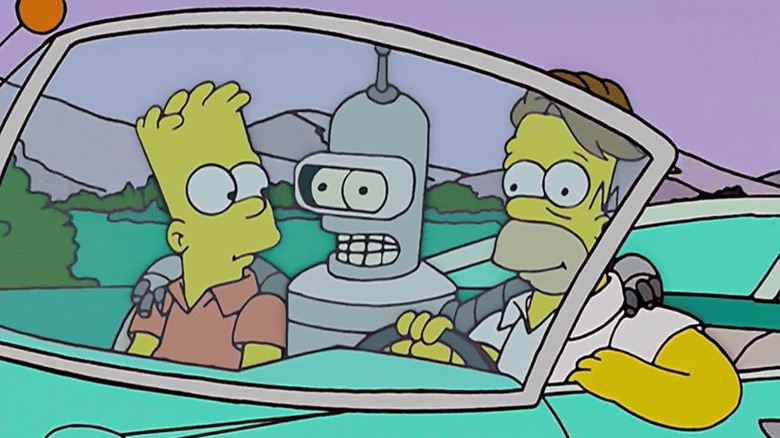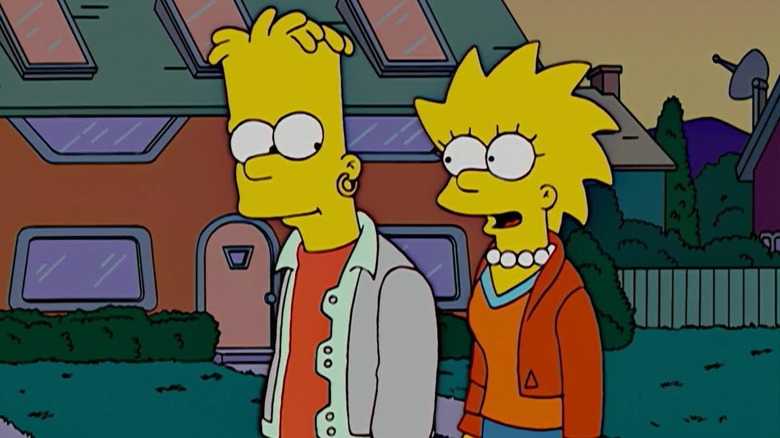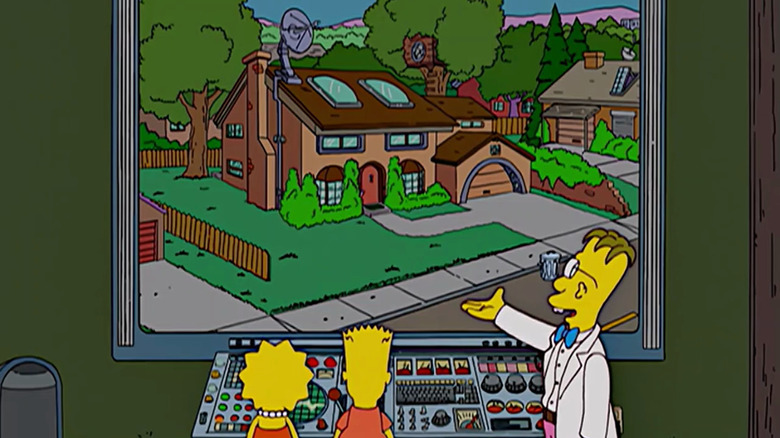The Simpsons' Futurama Crossover Broke A Long-Standing Matt Groening Rule
In the "The Simpsons" episode "Future-Drama" (April 17, 2005), Bart (Nancy Cartwright) and Lisa (Yeardley Smith) visit the mad scientist Professor Frink (Hank Azaria) to get a glimpse into their future. Frink has invented a future-predicting computer, and the Simpson children ask to see what they might look like as teenagers. In the year 2013, Bart is dating a cool skateboarder named Jenda (Amy Poehler) and Lisa, on her way to medical school, has had an on-again-off-again relationship with Milhouse (Pamela Hayden). Marge has been dating Krusty the Clown (Dan Castellaneta) after leaving Homer for committing a flagrant financial crime (he purchased a leaky, underwater home).
To ensure the episode is sufficiently surreal, there is a scene wherein the teenage Bart and the older Homer (Castellaneta) pass through a quantum tunnel and emerge on the other side with a robot they mysteriously accumulated. The robot is Bender (John DiMaggio), the drunken droid from Matt Groening's "Futurama," a series that, at the time, had recently been canceled for the first time. Bender announces that Bart and Homer are his new best friends. Homer calls Bender a loser and throws him out of the car, dashing him to pieces.
"Future-Drama" wasn't the first time "The Simpsons" peeked into the futures of its characters, of course, nor was it even the first to feel like a canonical posit of things to come. It was, however, the first time Bart and Lisa had been depicted as teenagers. It seems that this was something of a bugaboo. On the DVD commentary track for "Future-Drama," writer Matt Selman notes that Groening had a hard-and-fast rule about showing Bart and Lisa as teens. It was a rule Selman had to ask permission to break.
Teen Bart and Teen Lisa
Bart and Lisa had been seen as adults before, of course. Several episodes flashed forward to the distant future and saw the characters in various unexpected professions. In one timeline Bart was the Chief Justice of the Supreme Court, while in another, he worked in demolition. Lisa once grew up to be the president after Donald Trump. "Future-Drama" was the first time, however, they were seen extensively as adolescents.
This ran counter to the chronology of the series, which traditionally kept all the characters at exactly the same age. Bart was 10 years old in the 1989 premiere episode, and he's still 10 in 2024. The show has been running so long, the past has time-shifted forward. Initially, Homer met Marge in 1973. Later on, however, Homer and Marge's love story was transposed to the mid-1990s grunge scene. Groening liked that the characters never aged, allowing the family dynamic to remain in perpetuity.
Selman, when writing "Future-Drama," knew that Groening didn't want Bart and Lisa to ever be seen as teens, perhaps because he didn't like teenagers. It was Groening's aversion that served as inspiration. Selman said:
"The inspiration of this was, I believe, an interview with Matt, or one of Matt's frequent quotes is, 'The reason "The Simpsons" is good is because the characters can never get older and you'll never have to see Bart and Lisa as teenagers.' So I said, 'What if we saw Bart and Lisa as teenagers?' And that was the inspiration, breaking one of Matt's rules which is always fun."
Those who might have been miffed about the depiction of Bart and Lisa as teens can take comfort in the fact that, like all of the "Simpsons" flash-forwards, it's merely one possibility of what might happen.
But what about Bender?
The Bender cameo, meanwhile, was merely for fun. Since "Future-Drama" took place in 2013, the showrunners envisioned a technological future-scape with flying cars and other sci-fi conceits. As mentioned, Homer and Bart fly through a quantum tunnel, which is a tunnel built into the side of a cliff face ... but without an opening. Home drives directly into the cliff wall, passing through it. Bender's cameo was merely a sign that "The Simpsons" took place in the future. The characters from "Futurama" would cross over more extensively with the Simpsons in a TV event called "Simpsorama" (November 9, 2014). Fittingly, that episode was made after the "future" seen in "Future-Drama."
The fact that "The Simpsons" and "Futurama" could cross over at all, however, violates an unspoken rule Groening laid out in a "Futurama" commentary track. In the episode "A Big Piece of Garbage" (May 11, 1999), the Planet Express crew flies into space and finds a moon-sized ball of garbage, ejected from Earth 1,000 years before, now returning to wreak chaos. Bender sits through the garbage comet and finds a pile of discarded Bart Simpson toys. On the commentary, Groening pointed out that "The Simpsons" was merely an animated sitcom in the universe of "Futurama," and that "Futurama" was the real world.
This fun meta-joke was not necessarily violated with "Future-Drama," as that was merely a fictional, parallel timeline. It wouldn't be until "Simpsorama" that Groening's other rule, about the fictionality of "The Simpsons" would also be violated.
Rules, it seems, are like mom's good China. They were made to be broken.


